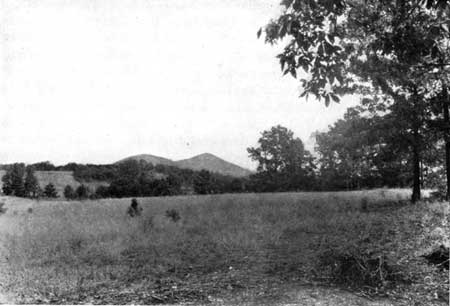MENU
|
Glimpses of Historical Areas East of the Mississippi River |
|
The War Between the States |
|
GEORGIA |
Special Feature: Picturesque field on which occurred one of the two heavy assaults made by Sherman on Confederate positions during the Atlanta campaign.

A Distant View of Kennesaw Mountain.
(Photo by Rinehart)
A THE opening of the campaign in the West in the spring of 1864, General Sherman, commanding a Federal army of about 100,000 men in the vicinity of Chattanooga, Tenn., was faced with the task of defeating the Confederate army under General Johnston, strongly posted across the railroad leading to its base of supply at Atlanta, Ga. The capture of that important railroad and manufacturing center lying about 110 miles south of Chattanooga was considered of immense strategic importance. Sherman expressed the conviction that the capture of Atlanta "would be the death knell of the Southern Confederacy", and from the 7th of May, when he began operations against Johnston's fortified positions about Dalton, Ga., he bent his energies toward reaching Atlanta, the possession of which would enable him to move either against Mobile, Ala., or Savannah, Ga., and thus gain access to the seacoast.
Both commanders displayed a high degree of tactical skill in the Atlanta campaign. Johnston, whose army at the beginning of the campaign amounted to some 54,000 men which number later was increased to about 72,000, opposed the Federal advance with great shrewdness. Avoiding combat under disadvantageous conditions, he was unable to force a pitched battle when conditions were favorable, and was maneuvered from one position to another by Sherman, operating around his left flank, until by the middle of June he had retired some 60 miles, and was only 25 miles from Atlanta. He then occupied a commanding trench position extending across the railroad in a semicircle about 9 miles long on the north and west sides of Marietta, at Kennesaw Mountain, and Cheatham's Hill.
Drawing his lines closely in front of Johnston's, Sherman determined on a direct assault, partly in order to prove both to his own men and those of his opponent that he had no fear of engaging Johnston's forces in battle. Five brigades were designated to make the principal attack, to be delivered against Cheatham's Hill in the hope of breaking through Johnston's center and thereafter rolling up and destroying both segments of his army. Two brigades on the right were to advance against Cheatham, while three brigades on the left attacked Clebourne's Division. Supporting attacks were arranged to be delivered on Kennesaw Mountain, and at the moment of the advance the artillery on the entire front of the army was to open fire.
At about 8:45 a. m., June 27, the Federal batteries opened all along the line and immediately were answered by the Confederates. The tremendous artillery duel shook the earth for 15 minutes as the assaulting columns advanced. But the Federal soldiers found the hillside steep and uneven and encountered a wide abatis in which they were entangled while under the hottest fire of the Confederate infantry and batteries. On the right, Mitchell's troops, though momentarily gaining a position flanking part of Cheatham's line, were driven back with heavy losses, as were Harker's, Wagner's, and Kimball's brigades on the left. The only force actually to reach the Confederate works was that of McCook. This gallant commander was killed at the head of his troops, but they succeeded in seizing a position close under Cheatham's breastworks. During the following night they entrenched their front, using bayonets, cups, and cartridge boxes as digging tools, and the works thus built and thereafter held are still visible today. As a whole, however, Sherman's assault on Kennesaw, as well as on Cheatham's Hill, was a costly failure, involving a Federal loss of about 3,000 men, while that of the Confederates was less than 500. After this battle, Sherman resumed his flanking movements, causing Johnston to evacuate his Kennesaw Mountain lines on July 2 and retire farther toward Atlanta.
Soon after the close of the war, the Col. Dan McCook Brigade Association, composed mainly of Illinois troops, bought the 60-acre tract of land on which their notable attack had been made and created it into a memorial park. On the fiftieth anniversary of the battle, June 27, 1914, a monument to the soldiers of Illinois was unveiled there.
Presented to the United States in 1917, the park remained under the control of the War Department until June 10, 1933, when it was transferred to the National Park Service, Department of the Interior. A collection of Civil War relics is on exhibition at the park.
NEXT> Brices Cross Roads National Battlefield Site
 Top
Top
Last Modified: Thurs, Nov 23 2000 10:00:00 pm PDT
http://www.cr.nps.gov/history/online_books/glimpses3/glimpses4h.htm
![]()
